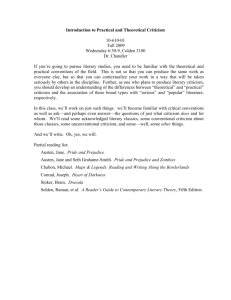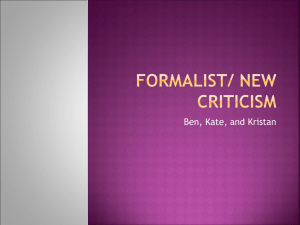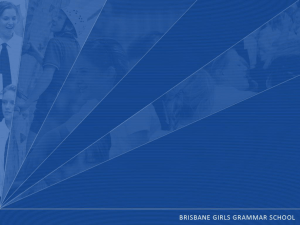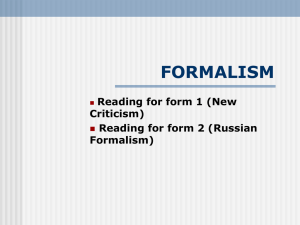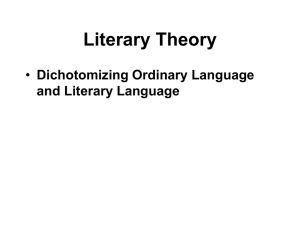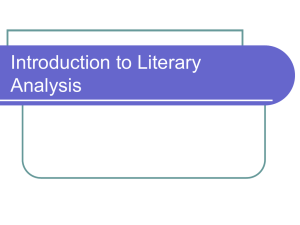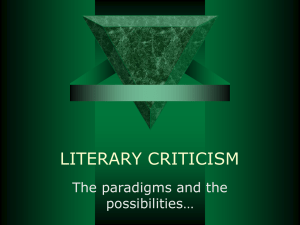Formalist literary criticism
advertisement
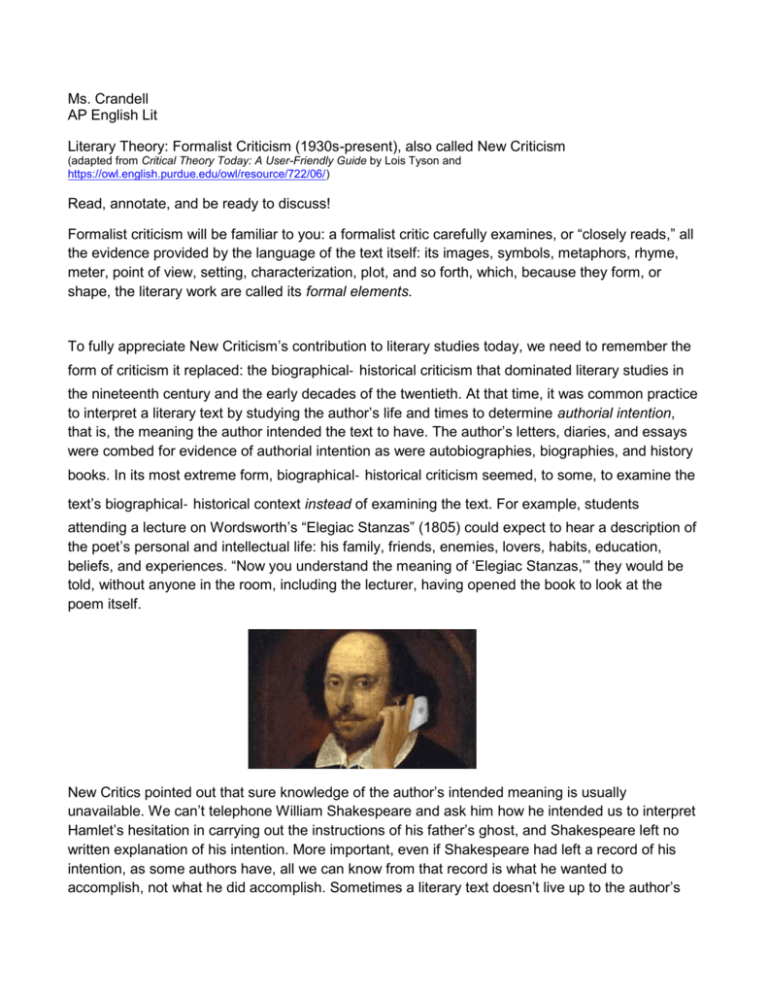
Ms. Crandell AP English Lit Literary Theory: Formalist Criticism (1930s-present), also called New Criticism (adapted from Critical Theory Today: A User-Friendly Guide by Lois Tyson and https://owl.english.purdue.edu/owl/resource/722/06/) Read, annotate, and be ready to discuss! Formalist criticism will be familiar to you: a formalist critic carefully examines, or “closely reads,” all the evidence provided by the language of the text itself: its images, symbols, metaphors, rhyme, meter, point of view, setting, characterization, plot, and so forth, which, because they form, or shape, the literary work are called its formal elements. To fully appreciate New Criticism’s contribution to literary studies today, we need to remember the form of criticism it replaced: the biographical‐ historical criticism that dominated literary studies in the nineteenth century and the early decades of the twentieth. At that time, it was common practice to interpret a literary text by studying the author’s life and times to determine authorial intention, that is, the meaning the author intended the text to have. The author’s letters, diaries, and essays were combed for evidence of authorial intention as were autobiographies, biographies, and history books. In its most extreme form, biographical‐ historical criticism seemed, to some, to examine the text’s biographical‐ historical context instead of examining the text. For example, students attending a lecture on Wordsworth’s “Elegiac Stanzas” (1805) could expect to hear a description of the poet’s personal and intellectual life: his family, friends, enemies, lovers, habits, education, beliefs, and experiences. “Now you understand the meaning of ‘Elegiac Stanzas,’” they would be told, without anyone in the room, including the lecturer, having opened the book to look at the poem itself. New Critics pointed out that sure knowledge of the author’s intended meaning is usually unavailable. We can’t telephone William Shakespeare and ask him how he intended us to interpret Hamlet’s hesitation in carrying out the instructions of his father’s ghost, and Shakespeare left no written explanation of his intention. More important, even if Shakespeare had left a record of his intention, as some authors have, all we can know from that record is what he wanted to accomplish, not what he did accomplish. Sometimes a literary text doesn’t live up to the author’s intention. Sometimes it is even more meaningful, rich, and complex than the author realized. And sometimes the text’s meaning is simply different from the meaning the author wanted it to have. Knowing an author’s intention, therefore, tells us nothing about the text itself, which is why New Critics coined the term intentional fallacy to refer to the mistaken belief that the author’s intention is the same as the text’s meaning. For New Criticism, the complexity of a text is created by the multiple and often conflicting meanings woven through it. And these meanings are a product primarily of four kinds of linguistic devices: paradox, irony, ambiguity, and tension. Briefly, paradox is a statement that seems self‐ contradictory but represents the actual way things are. For example, it is a biblical paradox that you must lose your life in order to gain it. On the surface, that phrase seems self‐ contradictory: how can you gain something by losing it? However, the phrase means that by giving up one kind of life, the transitory life of the flesh, you gain another, more important kind of life: the eternal life of the soul. Similarly, a paradox of everyday experience can be seen in the old saying Joni Mitchell uses so effectively in her song “Big Yellow Taxi”: “You don’t know what you’ve got ’till it’s gone.” Not unlike the biblical reference above, this old adage tells us that you have to lose something (physically) before you can find it (spiritually). Many of life’s spiritual and psychological realities are paradoxical in nature, New Critics observed, and paradox is thus responsible for much of the complexity of human experience and of the literature that portrays it. Irony, in its simple form, means a statement or event undermined by the context in which it occurs. The following description of a wealthy husband’s sense of moral rectitude, from Edith Wharton’s House of Mirth (1905), is an example of an ironic statement. Once in the winter the rector would come to dine, and her husband would beg her to go over the list and see that no divorcées were included, except those who had showed signs of penitence by being remarried to the very wealthy. Part of the ironic implication of this passage is that the husband is a hypocrite: he condemns divorce only if it is not followed by the acquisition of equal or greater wealth, so what he really condemns, under the guise of moral principles, is financial decline. An example of an ironic event can be seen in Toni Morrison’s The Bluest Eye (1970) when Pecola finally receives the blue eyes she has wished for so desperately. Her wish has been “fulfilled” only because she has lost touch with reality so completely that she believes her brown eyes are blue. Ambiguity occurs when a word, image, or event generates two or more different meanings. For example, in Toni Morrison’s Beloved (1987), the image of the tree produced by the scar tissue on Sethe’s back implies, among other things, suffering (the “tree” resulted from a brutal whipping, which is emblematic of all the hardships experienced under slavery), endurance (trees can live for hundreds of years, and the scar tissue itself testifies to Sethe’s remarkable ability to survive the most traumatic experiences), and renewal (like the trees that lose their leaves in the fall and are “reborn” every spring, Sethe is offered, at the novel’s close, the chance to make a new life). In scientific or everyday language, ambiguity is usually considered a flaw because it’s equated with a lack of clarity and precision. In literary language, however, ambiguity is considered a source of richness, depth, and complexity that adds to the text’s value. Finally, the complexity of a literary text is created by its tension, which, broadly defined, means the linking together of opposites. In its simplest form, tension is created by the integration of the abstract and the concrete, of general ideas embodied in specific images. For example, in Arthur Miller’s Death of a Salesman (1949), the concrete image of Willy’s tiny house, bathed in blue light and surrounded by enormous apartment buildings that emanate an angry orange glow, embodies the general idea of the underdog, the victim of forces larger and more numerous than itself. Similarly, the concrete image of Linda Loman singing Willy to sleep embodies the general idea of the devoted wife, the caretaker, the nurturer. Such concrete universals—or images and fictional characters that are meaningful on both the concrete level, where their meaning is literal and specific, and on the symbolic level, where they have universal significance—are considered a form of tension because they hold together the opposing realms of physical reality and symbolic reality in a way characteristic of literary language. In other words, the Loman home and the character of Linda Loman represent both themselves and something larger than themselves. The complexity of the text, to which all of these linguistic devices contribute, must be complemented by a sense of order if a literary work is to achieve greatness. Therefore, all of the multiple and conflicting meanings produced by the text’s paradoxes, ironies, ambiguities, and tensions must be resolved, or harmonized, by their shared contribution to the theme. The text’s theme, or complete meaning, is not the same thing as its topic. Rather, the theme is what the text does with its topic. Typical questions: How does the work use imagery to develop its own symbols? (i.e. making a certain road stand for death by constant association) What is the quality of the work's organic unity "...the working together of all the parts to make an inseparable whole..." (Tyson 121)? In other words, does how the work is put together reflect what it is? How are the various parts of the work interconnected? How do paradox, irony, ambiguity, and tension work in the text? How do these parts and their collective whole contribute to the aesthetic quality of the work? How does the author resolve apparent contradictions within the work? What does the form of the work say about its content? Is there a central or focal passage that can be said to sum up the entirety of the work? Let’s do a close reading of Lucille Clifton’s “There Is a Girl Inside” (1977). There Is a Girl Inside there is a girl inside. she is randy as a wolf. she will not walk away and leave these bones to an old woman. she is a green tree in a forest of kindling. she is a green girl in a used poet. she has waited patient as a nun for the second coming, when she can break through gray hairs into blossom and her lovers will harvest honey and thyme and the woods will be wild with the damn wonder of it.
